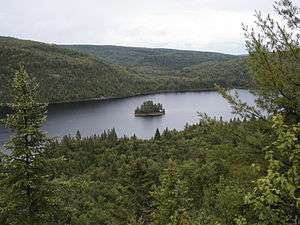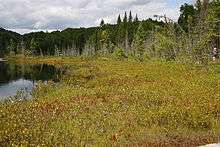La Mauricie National Park
La Mauricie (Parc national de la Mauricie) is a Canadian national park in the Mauricie region of Quebec.

Understand
The park is near Shawinigan in the Laurentian mountains, in the Mauricie region. It covers 536 km2 (207 sq mi) in the southern Canadian Shield region bordering the Saint Lawrence lowlands. The park has 150 lakes and many ponds.
The park is named after the nearby Saint-Maurice River to the east of the park. The Matawin River flows along the western and northern borders of the park.
Unlike other national parks, no dogs are permitted.
- Parks Canada, ☎ +1 819-538-3232, toll-free: +1 888-773-8888, e-mail: information@pc.gc.ca.
Hours of operation
Winter Season 2017-2018: Saint-Jean-des-Piles Entrance every day from December 9, 2017 to April 1, 2018
Summer Season 2018: Saint-Mathieu-du-Parc Entrance: every day from May 17 to October 8, 2018
History
The earliest human remains in the park date from between 7000 and 3000 BCE. The 34 “protohistoric” archeological sites suggest that Native Americans who frequented the park lived in small family groups. A cliff of Lake Wapizagonke has some of the few North American cave paintings preserved from that era, which testify to the spirituality of ancient Native Americans. Until the 17th century, the Attikamekw and Algonquian peoples respectively lived by trapping and hunting in the northern and southern basins of the Saint-Maurice River. The Abenaki used the park area in the middle of the 19th century for hunting and trade.
At the beginning of the 19th century, European Canadians began logging the area, cutting white and red pines for lumber. This lasted until 1925, when trees of good diameter became scarce. The forest industry then turned instead to wood for paper, which made the Mauricie one of the largest producers of newspaper for the first half of the 20th century. In addition to logging, the industry greatly altered the balance of forests by planting the white spruce across 426 hectares (1,050 acres) and causing forest fires in 1910 and 1954.
At the end of the 19th century, rich American tourists settled in the area and opened private hunting and fishing clubs. The park was created on August 21, 1970. The Wabenaki and Andrew lodges, properties of Laurentian Club, located on the edge of lac à la Pêche (Lake of Fisheries), were acquired by Parks Canada in 1972 and were converted into dormitories and rooms for visitors.
Landscape
The park contains 150 lakes and many ponds. The park lies within the Eastern forest-boreal transition ecoregion. The forests in this region were logged from the middle of the 19th century to the early 20th century. The park's forests have regrown and contain a mixture of conifers and mixed deciduous trees.
Flora
The park lies within the Eastern forest-boreal transition ecoregion. The forests in this region were logged from the middle of the 19th century to the early 20th century. The park's forests have regrown and contain a mixture of conifers and mixed deciduous trees.
The park contains more than 440 species of vascular plants 68 species of lichens and more than 85 species of mosses. The park also has 27 species of rare plants or special interest.
Forest covers 93% of the territory. It is at the northern treeline leafyes Quebec. There are 30 species of different trees. The park is part of habitat ranges from maple to yellow birch (Acer saccharum and Betula papyrifera), which occupies the illuminated slopes and well-drained soils. The Balsam firs (Abies balsamea) and the pine (Pinus sp) and spruces (Picea sp) occupy the rocky cliffs and wetlands. It includes an endangered species, the butternut (Juglans cinerea).
Fauna
Wildlife in the park includes moose, black bears, beavers and otters. It supports a small number of wood turtles, rare in Canada. At least 50 species of mammals inhabit the park, such as the coyote (Canis latrans), red fox (Vulpes vulpes), lynx (lynx canadensis), moose (Alces alces), black bear (Ursus americanus), snowshoe hare (Lepus americanus), squirrel (Tamiasciurus hudsonicus), little brown bat (Myotis lucifugus) and cinereus shrew (Sorex cinereus). Of these, 2 are Artiodactyla, 13 carnivores, 16 rodents, 8 bats, 10 insects and 1 lagomorph. One species that is considered endangered is the eastern wolf (Canis lyacaon).
There are also over 180 species of birds, including at least 81 nesting species. Among these there are 12 species of raptors and 34 species of aquatic birds. Coniferous forests are frequented by ruby-crowned kinglet (Regulus calendula), the Tennessee warbler (Oreothlypis peregrina), the Nashville warbler (Oreothlypis ruficapilla), the magnolia warbler (Dendroica magnolia), the hermit thrush (Catharus guttatus), the grosbeak (Hesperiphona vespertina) and the dark-eyed junco (Junco hyemalis). Mixed forests are occupied by the ruffed grouse (Bonasa umbellus), the blue jay (Cyanocitta cristata), the black-capped chickadee (Poecile atricapillus) and the purple finch (Carpodacus purpureus). The ovenbird (Seiurus aurocapilla), the black-throated blue warbler (Dendroica caerulescens), the veery (Catharus fuscescens), the red-eyed vireo (Vireo olivaceus), the eastern wood pewee (Contopus virens) and the sapsucker (Sphyrapicus varius) inhabit the hardwood forests. The most common raptors observed are (Pandion haliaetus) the broad-winged hawk (Buteo platypterus), the barred owl (Strix varia) and the great horned owl (Bubo virginianus). Aquatic areas servs as nesting habitat for the common goldeneye (Bucephala clangula), the merganser (Mergus merganser), the black duck (Anas rubripes) and finally the common loon (Gavia immer), which is the emblem of the park. The park includes eight species at risk, the whip-poor-will (Caprimulgus vociferus), the nighthawk (Chordeiles minor), the chimney swift (Chaetura pelagica), the olive-sided flycatcher (Contopus cooperi), the Canada warbler (Wilsonia canadensis), the peregrine falcon (Falco peregrinus) and the rusty blackbird (Euphagus carolinus).
The park includes only five species of reptiles: the wood turtle (Glyptemys insculpta), the painted turtle (Chrysemys picta) and three species of snake, including the garter (Thamnophis sirtalis). It is also attended by fourteen species of amphibians including six salamanders and eight frogs. One species, the wood turtle is considered endangered.
Most lakes have a relatively poor fish fauna due to the youth of the country. The brook trout (Salvelinus fontinalis) is most commonly found, especially in the north of the park. The Isaiah, the French and the Bérubé are found at lower altitudes, where lakes have the greatest biodiversity, as well as populations of stickleback(Pungitius pungitius) and spoonhead sculpin (Cottus ricei). The lakes also have the only French population of char (Salvelinus alpinus) of the park. This population was threatened by the introduction at the beginning of the century of several invasive fish species, such as chub (Semotilus atromaculatus). 19 species of fish have been introduced by humans over the 19th and 20th centuries.
Climate
| Months | Normal | Warmest | Coldest |
|---|---|---|---|
| January | -14.4°C | -8.3°C | -20.4°C |
| February | -12.3°C | -5.5°C | -19.2°C |
| March | -4.6°C | 1.8°C | -11.1°C |
| April | 3.6°C | 9.6°C | -2.6°C |
| May | 10.7°C | 17.5°C | 3.9°C |
| June | 16.4°C | 23.2°C | 9.4°C |
| July | 18.9°C | 25.5°C | 12.3°C |
| August | 17.7°C | 23.7°C | 11.6°C |
| September | 12.6°C | 18.1°C | 6.9°C |
| October | 6.3°C | 10.9°C | 1.7°C |
| November | -1.1°C | 2.6°C | -4.8°C |
| December | -10.9°C | -5.9°C | -16.0°C |
The warmest is 25.5°C the coldest is -20.4°C
La Mauricie can even be 12.3°C in the winter!
In summer it goes from 9.6°C to 25.5°C.
Get in
The Mauricie National Park is about 15 km (9.3 mi) north of Shawinigan, about 45 km (28 mi) north of the city of Trois-Rivières, 195 km (121 mi) northeast of Montreal, and 160 km (99 mi) east of Quebec City.
It is bordered by the Saint-Maurice River to the east and the Matawin River to the north. It is accessible from the villages of Saint-Jean-des-Piles and Saint-Mathieu-du-Parc. Secondary access is also possible by Saint-Gérard-des-Laurentides.
- Saint-Jean-des-Piles entrance: Highway 55, exit 226 via Chemin du parc national road sign
- Saint-Mathieu entrance: Highway 55, exit 217 via Saint-Mathieu-du-Parc
- Park Bus, ☎ +1-800-928-7101. During the summer, Park Bus runs shuttle buses from Montreal Tourist Information Center at 1255 Peel Street (metro station Peel is 200 m away). Departure 08:00 (arrive 30 min before), arrival at Rivière-à-la-Pêche service centre at ~10:30. Return departure 15:30, arrival ~18:00. Adults $45, students and seniors $41, children $23.
Fees and permits
Daily fees (2018):
- Adult $7.80
- Senior $6.80
- Youth and children under 18 free
- Family/group $15.70
Seasonal passes/purchased before last Sunday in May (2018):
- Adult $ 39.20/$ 31.40
- Senior $ 34.30/$ 27.40
- Youth and children under 18 free
- Family/group $ 78.50/$ 78.50
Fishing permits (2018):
- Daily $ 9.80
- Annual $ 34.30
Winter activities
(includes admission fees, Parks Canada Discovery pass does not apply) (2018):
Cross-country skiing - daily/seasonal
- Adult $ 9.80/$ 49.00
- Senior $ 8.30/$ 41.20
- Youth and children under 18 free
Snowshoeing and winter hiking - daily/seasonal (2018):
- Adult $ 7.80/$ 39.20
- Senior $ 6.80/$ 34.30
- Youth and children under 18 free
Parks Canada Passes
The Discovery Pass provides unlimited admission for a full year at over 80 Parks Canada places that typically charge a daily entrance fee It provides faster entry and is valid for 12 months from date of purchase. Prices for 2018 (taxes included):
- Family/group (up to 7 people in a vehicle): $136.40
- Children and youth (0-17): free
- Adult (18-64): $67.70
- Senior (65+): $57.90
The Cultural Access Pass: people who have received their Canadian citizenship in the past year can qualify for free entry to some sites.
Get around
See
- Lac-Édouard. A beautiful beach and a playground for children. Interpretive trail of Lac-Étienne. This area meets, in addition, the standards of universal access.
- Shawenegan Picnic Area. A network of short hiking trails. In addition to swimming, boat rental, snack bar.
- Wapizagonke. This day trip includes 13 km (8 miles) of canoeing on Lake Wapizagonke and a minimum of 10 km (6 miles) of hiking. No portages. Spectacular views of Lakes Wapizagonke and Anticagamac, and the most beautiful waterfalls in the park.
- Visitors Centre. Multi-media displays and historical background about the trees, wildlife, and early explorer interaction with First Nations people.
Do

- The park is a popular location for camping, canoeing and kayaking.
- There are many trails for hiking or snow-shoeing.
- The park offers a canoe camping circuit allowing access to a dozen lakes in the hinterland connected by many portages. This circuit allows accessing to some 200 camping sites that are accessible only by boat.
- A drive through the park is about 64 km and provides spectacular views of the Maurice River and Lac Wapizagonke, and many opportunities for camping, swimming, picnics, canoe rentals, hiking through the forest, and wildlife sighting.
Buy
- Canoe, kayak and stand-up paddle board rentals, e-mail: locationcanot@gmail.com. Rental reservations available through the website. New and used equipment for sale. $43-49 per day.
Eat
Drink
Sleep
Lodging
- Domaine Wabenaki – Andrew, ☎ +1 819 537 4555, e-mail: info@info-nature.ca. Stay in Le Chalet Wabenaki or La Maison Andrew.
- oTENTik, ☎ +1 519-826-539 (outside of North America), toll-free: +1-877-737-3783. Check-in: 15:00, check-out: 11:00. A cross between a tent and a rustic cabin, Parks Canada oTENTik tents offer a blend of comfort and outdoor adventure. 13 4-season units are available at the Rivière à la Pêche campground. 12 3-season units are available at the Mistagance campground. The F-7 site of the Rivière à la Pêche campground has universal access. $120 per night (taxes included).
Camping
- Camping reservations are available through the Parks Canada website.
Camping fees per night (2018):
- Unserviced with toilets and showers $ 25.50
- Serviced with electricity $ 29.40